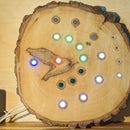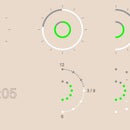Introduction: Sit&Stand Computer Desk Hutch
You spend most of your daytime sitting: working in the office or studying in the library, home at night. It would be nice to switch from sitting to standing position without activity interruption, right? This is possible with some sit-n-stand station available online but that will cost you $350+. This hutch costs me half of that price. It allows me to switch from siting to standing positions within seconds and in addition serves me as office organizer.
Step 1: Tools and Materials
This project did not require precision machinery or expensive tools. On the photo you can see hand tools used for the job.
- Hand Saw (wood)
- Fiskar hand drill and some drill bits
- Hack saw (metal)
- IKEA FIXA tool set (For $7.99(!) you can get several tools of decent quality)
Some items were leftovers of my previous projects: metal corners, rope, screws, nails, paint etc, but most materials I got from local Home Depot and Ace Hardware Stores specially for this project:
- Three pine wood common boards (1 in. x 12 in. x 6ft) for hutch
- One pine common boards (1 in. X 6 in. x 6 ft) for shelves and monitor desk side walls
- Two poplar hobby boards for a monitor and keyboard desk and hardboard sheet for rear wall
- Pair of draw sliders
- Three 4 ft shelves stands for counterweight rails and keyboard rods
- Three pairs of patio door wheels for pulley system
- Two hinges for desk stops
- Two wooden knobs for desk stops
- Three c-clamps to fix the monitor to the monitor desk and hutch to the computer desk
Step 2: Making Elements of the Hutch
I made elements of the hutch out of three pine wood common boards from the Home Depot (1 in. x 12 in. x 6ft). On the picture you can see that these elements lay on the sheet of hardboard. That would be the hutch rear wall. Size of elements depends on your height and size of your monitor/laptop. I used 1020 mm length for walls and 615 mm for the roof.
Step 3: Preparing Side Walls
First I disassembled draw sliders. To the inner parts of the sliders I have attached monitor desk sides. After assembling sliders back I attached them to edges of walls. Monitor (or laptop) will slide up and down on these sliders. On other edge of the wall I installed metal shelf stands. These will be used as rails for the counterweight.
Step 4: Assembling the Hutch
I drilled four holes (two at the top and two at the bottom) through each wall and through the roof. Then I assembled the hutch by nailing it and later enforced it with additional drilling and cabinet screws. Hammer, small hand drill and screwdriver is what you need for that.
Step 5: Making the Monitor Desk
Wooden rod is glued and put inside opening of the desk sides. Then desk itself (made out of hobby board) is attached to the rod and sides by screws.
Step 6: Adding Keyboard Desk and Installing the Counterweight System
Keyboard and mouse desk made out of hobby board is attached to the monitor desk with shelf stands (the same as I have used for counterweight rails). I wanted for the hutch not to be too heavy so I have used system with 6 pulleys which provides two times mechanical advantage. Counterweight board was moved into the dedicated rear rails, then 6 pulleys were installed with metal corners to the desk and roof. Later ropes were attached to each side of the system (see these elements in details at next step). Event empty desk outweighs counterweight board. To fix that I have to install two 2.5 pounds training weights on each side of the board. After that 8 pounds testing weight is properly balanced by counterweight.
Step 7: Countreweight System (Pullley Instalation)
Pictures above illustrate installation of pulleys and counterweight system
Step 8: Attaching Stop Hinges, Inner Shelves and Monitor
After choosing appropriate standing position for the monitor I have installed two hinges on the front sides of hutch walls. Wooden knobs added for convenience. These hinges serves as stops for the desk in top position. Two inner shelves I put inside the hutch to hold audio columns and some office supplies. While setting monitor on the desk I have tied it with two small C-clamps to the monitor desk. Bigger C-clamp fixes the hutch on the desk. My desk has the round hole for a computer wiring and I put C-Clamp though this hole. Now the hutch is ready. While making this post I switched from sitting to standing twice.

Third Prize in the
DIY University Contest

Participated in the
Hand Tools Only Contest











